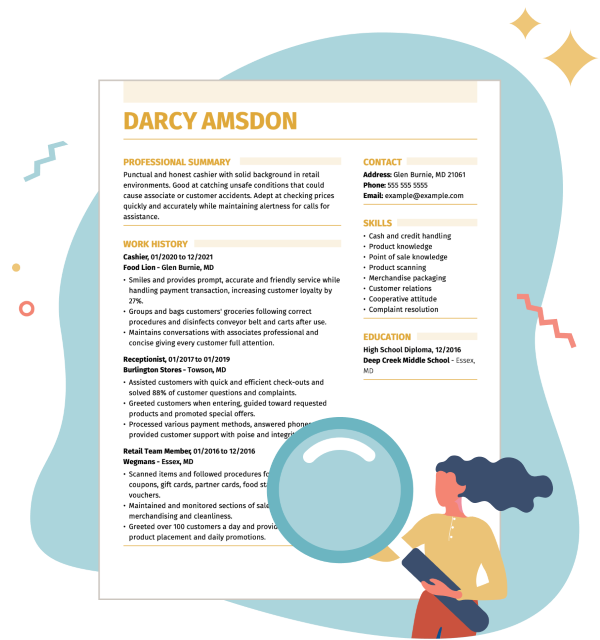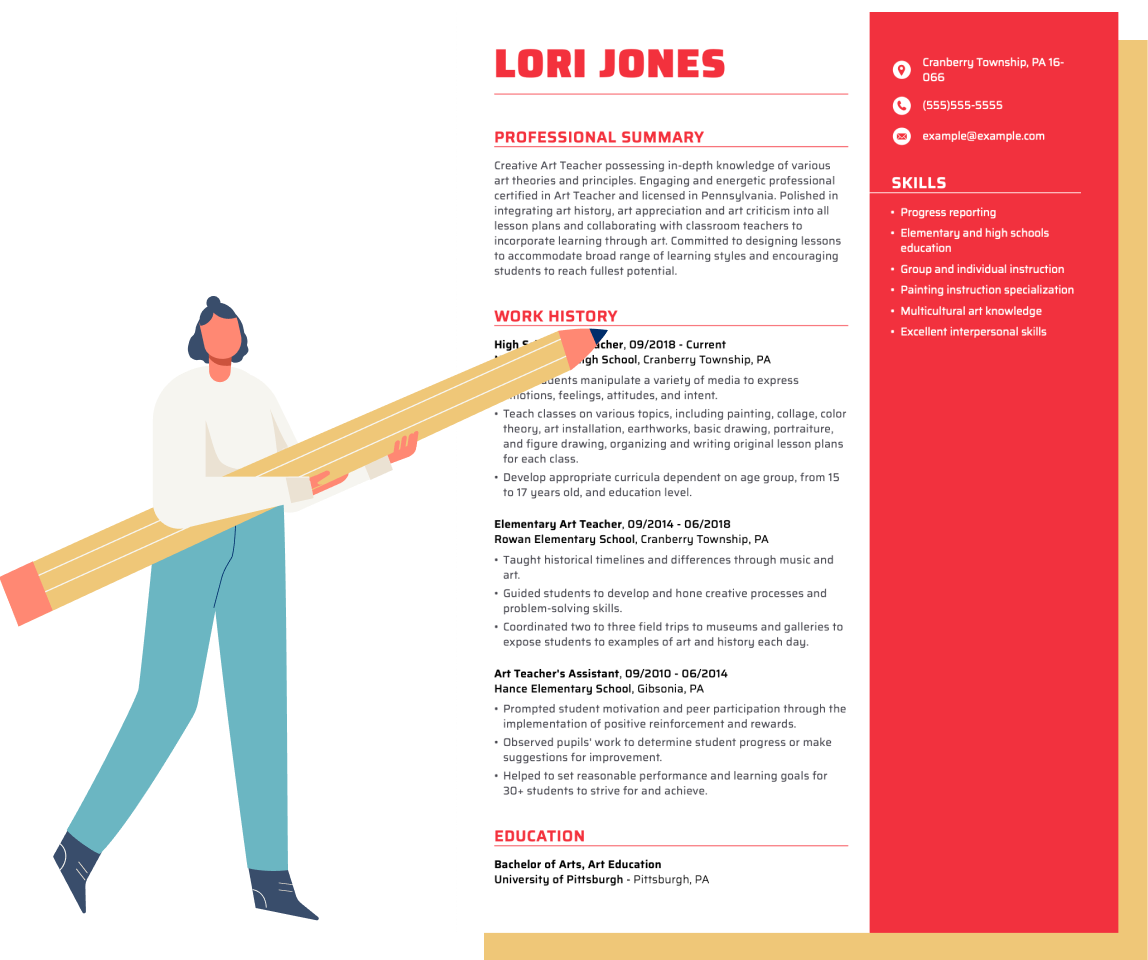Chronological Resume Format: Templates & Examples

Learn how to write a masterful chronological resume that lets your professional achievements shine, and use a free resume template to help you take your resume from ordinary to extraordinary.
Our customers have been hired at:*Foot Note
What is a chronological resume?
The chronological resume — also known as the reverse chronological resume — is a popular resume format highlighting work experience over skills and education. Hiring managers and recruiters like chronological resumes because they display your career accomplishments and progression upfront.
The chronological resume format is popular among job seekers with steady and progressive work histories. It is less suitable if you are changing careers, writing a resume with no work experience or have significant employment gaps. For these situations, you might choose the functional or combination resume.
Choose a chronological resume template, designed by experts to be ATS friendly!
Chronological resume templates for top jobs
Get tips for creating a chronological resumes and professionally-written resumes for top jobs. Find inspiration to highlight your own relevant experience. Looking for more options? Browse our library of resume templates.
What type of jobseeker would most benefit from a chronological resume?
If you’re unsure if the chronological resume format is the best choice for you, think about your work history. A chronological resume might be the most effective option if you fit into any of the following categories.
You’ve shown consistent growth in your career.
Hiring managers want to see a clear pattern of success on your resume. Since the reverse-chronological resume format highlights your job titles, promotions and accomplishments, it’s a great option if you have had a steady career progression. Give three to five examples of your top achievements for each job.
The job ad emphasizes experience.
Having knowledge of your field and the skills to perform the work required is a good start, but some potential employers want to know that you can apply your qualifications in a work setting. Convince them by prominently displaying what you have done for previous employers. Use the chronological resume format to showcase specific measurable achievements for each job in your work history.
There are no gaps in your employment history.
Since a chronological resume puts your employment history front and center, it’s the best resume format for displaying a steady and strong employment history over a long period.
Tips for making an exceptional chronological resume
Now that you know the structure of a chronological resume and how to make one, follow these tips to impress hiring managers and distinguish yourself from other job applicants.
1. Tailor your chronological resume to the job requirements.
If you want potential employers to notice you, you mush show you can fill their need. This means tailoring your resume to match the job for which you are applying.
- Take time to read the job description closely and take note of the required skills and experience.
- Then, find matches between those requirements and your own work history and skills.
- Next, create a list of measurable accomplishments from each of your former jobs, focusing on those that align with the required job-relevant skills and experience.
- Finally, weave those skills and accomplishments into your resume’s summary/objective, work history and skills section.
2. Use action words and numbers for impact
Action words and numbers are powerful tools to help you make your chronological resume stand out. Resume action words are verbs that describe your work accomplishments, such as “Streamlined the onboarding process for new employees”, while numbers provide concrete insight into your abilities, such as ” …resulted in a 25% improvement in productivity.”
When used together, action verbs and numbers can help you paint a clear picture of how you’ve made a positive impact in the past, and how you may perform for your potential employer if you’re hired.
For example, “Streamlined the onboarding process for new hires, resulting in a 25% improvement in productivity.”
3. Make your chronological resume ATS-friendly
An applicant tracking system (ATS) is software used by many employers to manage and screen resumes. Here are some tips for making your chronological resume ATS-friendly:
- Use a resume grader. We recommend using our ATS resume checker to scan your resume for common issues that might prevent it from passing screening software.
- Use keywords. Many ATS programs scan resumes for specific resume keywords. Include relevant keywords from the job description throughout your resume.
- Use simple formatting. ATS programs may have trouble reading resumes with complex formatting, such as tables, graphics and images. Use bullet points and acceptable resume fonts, to ensure that your resume is readable by the system.
- Use standard section headings. Use section headings such as “work experience,” “education” and “skills” to make it easy for the ATS to identify each section clearly.
4. Add optional sections
Optional sections can enhance your chronological resume in several ways, including:
- Magnifying certain skills. For example, if you have a lot of experience in a particular field and you have enough room on your resume, you can create separate skills sections like “technical skills” or “computer skills.”
- Providing more details about your work history. For example, if you have won an award for your work, you can emphasize it in an “Awards” section to make it stand out from your other accomplishments.
- Accentuating your expertise. For example, you could create a” special projects” section to showcase some of your work.
- Highlighting professional development. Creating a section for training or certifications –– especially if your field requires them –– can have a positive impact.
- Showing your personality. For example, if you are a volunteer or have relevant hobbies and interests that you are passionate about, you could create a “Volunteer Experience” or a “Hobbies and Interests” section to get the right attention.
How to spotlight skills and achievements in your chronological resume
Your professional and educational achievements are the keys to showing how you’ve made an impact, and your professional skills should demonstrate to the employer you have what it takes to succeed. Here are some tips for using them effectively.
- In your resume summary: Highlight three to five job-relevant skills and something you achieved with at least one of them. For example,
“Dedicated and experienced software engineer with 10+ years of experience in the industry. Proven ability to work independently and as part of a team, and to meet deadlines and project goals. Strong programming skills in Java, Python, C++, and C#. Created a new software application using Java that streamlined the company’s sales process and it increased sales by 15%.” - In your work history: Show what you’ve accomplished using the skills required for the job whenever possible. For example:
- Increased student test scores by 10% in math and reading over the past two years. (This example demonstrates how the job candidate applied effective teaching strategies on the job).
- Developed and implemented a new reading program that raised student participation by 20% in three months. (This example shows how the candidate used creativity and innovation).
- Won award for best teacher three years in a row for creating a positive and supportive classroom environment where students feel safe and respected. (This example illustrates that the candidate is compassionate).
- In your education section: Your chronological resume education section is another place to highlight skills you could not fit in your resume skills section and provides another opportunity to showcase your accomplishments.
Here’s an example:
Education University of California, Berkeley Berkeley, CA Bachelor of Arts in Political Science GPA: 3.9- Dean’s List
- Graduated with Honors
- President of the Political Science Club
- Member of the Debate Team
- Interned for the California State Assembly
- In an optional section: The optional sections of your resume provide opportunities to show how you have applied your job-related skills to accomplish professional projects, volunteer or community projects — even hobbies (if relevant and necessary)
For example: Volunteer activities Habitat for Humanity, May – September, 2021- Led a team of volunteers in the construction of a new playground for a local elementary school.
- Managed the project from start to finish, including fundraising, design and construction.
- Completed the project in four months within budget.
Key takeaways
Now you know the secrets to making an impressive chronological resume. Let’s recap:
- Chronological resumes highlight your work history over skills and education.
- Chronological resumes suit job seekers with a steady or progressive work history.
- If you have no work experience, consider a functional resume.
- A combination resume may be a better option if you are changing careers or have more than 10 years of work experience.
- Measurable achievements should form the base of your chronological resume. Use them instead of day-to-day tasks in your work history section.
- Action verbs and performance numbers can boost any resume, especially a chronological resume; use them when describing your work achievements.
Write a chronological resume in minutes with our Resume Builder
1Stand out with MyPerfectResume’s eye-catching templates! Building an impressive resume has never been easier or faster.
2Don’t get stuck writing about your work experience. Our Resume Builder has pre-written, industry-specific bullet points to create an impressive resume.
3Need your resume in PDF, word, or an image file? You’re in control with multiple export and download options.
4With resume score and resume check, we’ll rate the strength of your resume and guide you through actionable steps to make a resume that showcases your best professional self!
5Copy and paste a job description from any listing and get a job-specific resume match score. We’ll guide you through tailoring your resume for the job!
6With Smart Apply, we’ll help you find an opportunity, customize your resume, create a matching cover letter, and download your documents. We’ll even send you to the web page where you can apply!
FAQ
Why are chronological resumes better?
Chronological resumes are better for job seekers who have worked for at least one year and have a consistent work history, but not necessarily for other job candidates such as career changers and first-time job applicants.
The chronological resume is the most common format because it:
- Makes it easy for recruiters and hiring managers to see your job history.
- Allows hiring managers and recruiters to quickly see if your experience matches their needs.
- Highlights your work achievements from previous jobs.
- Displays your skills clearly.
How do you write a resume that stands out using the chronological resume format?
Try the following no-fail tips to make your chronological resume shine:
- Use a professional resume template to give your resume a professional and polished look. Our premium and free resume templates are professionally designed, ATS-friendly and easy to customize.
- Make a great first impression with an enticing professional summary. Think of it as an elevator pitch — a short but compelling overview of your top qualifications. For example, “Attentive and knowledgeable massage therapist with a five-year track record of solid customer service and a knack for building relationships. Experienced in various massage techniques, including deep tissue, Shiatsu and trigger points.”
- Make an impact with accomplishments. Hiring managers want to see what you can do for them rather than a list of tasks you performed at previous jobs. For every job you list, write at least three measurable achievements. Be specific and use numbers to make your point. For example, “Increased customer satisfaction by 30% in two months.”
Will the chronological resume format work for me if I’ve never had a job?
Since chronological resumes spotlight your employment history, we suggest using the functional resume format if you are writing a resume with no experience. A functional resume is great for first-time job applicants because it highlights skills and education.
How many pages should a chronological resume be?
Ideally, a chronological resume should be one page long. Two pages are acceptable if you have more than 10 years of experience and you think it’s useful to share your entire work history. If you think you need more than one page for your chronological resume, ensure it’s concise, relevant and easy to read or consider using the combination resume format.
Where should you add education in a chronological resume format?
Education should be added after your skills section on a chronological resume. List your educational background in reverse-chronological order and if applicable, include each school, degree, major subject and graduation date. You may also include any relevant coursework, academic honors or extracurricular activities.
What does a reverse-chronological resume emphasize?
A chronological resume emphasizes your work experience, career progression and professional achievements. List your work experience in reverse-chronological order, starting with your most recent job.
The chronological resume format is useful for potential employers because it lets them quickly see if you have the experience they want in a potential candidate. By highlighting what you achieved in each position, you give them a sneak peek into what you can do for them. Employers love seeing concrete examples on resumes!
What does a chronological resume look like?
A chronological resume typically has a simple and clean layout, with clear headings and bullet points to make it easy to read.
Chronological resumes typically include the following sections:
- Contact Information: This section includes your name, phone number, email address and mailing address.
- Professional Summary: A brief statement summarizing your career goals and professional experience.
- Work Experience: This section lists your work experience in reverse-chronological order, starting with your most recent job. Each job listing typically includes the job title, company name, employment dates and key responsibilities.
- Skills: This section lists any relevant skills that pertain to the job you’re applying for, such as technical skills, language proficiency or other relevant qualifications.
- Education: This section lists your educational background, including your degree, major, institution and graduation date.
- Certifications: Optional section that can give the employer a glimpse of your relevant certificates.
- Awards and recognition: Optional section that demonstrates that you are a high achiever and that you have been recognized for your hard work and dedication.
When is a chronological resume a bad choice?
While a chronological resume can effectively showcase your work history and career progression, it may not be advantageous in certain situations. Here are some scenarios when a chronological resume may not be the best option:
- Limited work experience: A chronological resume may not be the best choice if you are a recent graduate or have limited work experience. In this case, a functional resume may be a better option, as it focuses on your skills and abilities rather than your work history.
- Career change: If you are changing careers, a chronological resume may not highlight the relevant skills and experience you have gained in your previous jobs. In this case, a combination resume, highlighting your transferable skills and relevant work experience may be a better option.
- Employment gaps: If you have significant gaps in your employment history, a chronological resume may draw attention to these gaps and raise questions about your work history. A functional or skills-based resume that focuses on your skills and abilities may be a better option.
How can I emphasize accomplishments and numbers in my chronological resume work history effectively?
Here’s how to write an effective work history section on a chronological resume:
When you write your work experience section, add the titles of the jobs you’ve held and the dates you worked there. Underneath each job title:
- Feature three to five bullet points that highlight your top responsibilities or accomplishments.
- Begin each statement with a powerful action verb like “adjusted,” “analyzed,” “compiled,” “created” or “implemented.”
- Use quantifiable achievements in your chronological order resume to show how you’ve excelled at previous jobs. For example: “Collaborated with the motion capture department to collect data for over 100 specific characters and apply them to animations” or “Managed $500,000 budget, improving processes that resulted in a 17% reduction in costs from the previous year.”
How we reviewed this article
Since 2012, we have helped more than 11 million job seekers. We want to make your career journey accessible and manageable through our services and Career Center’s how-to guides and tips. In our commitment to bring you a transparent process, we present our Editorial Process.
Sources
- Ginger Software. Writing Center. Article. Chronological Resume
- Coursera. Article. Chronological Resume Guide: Template and Tips

